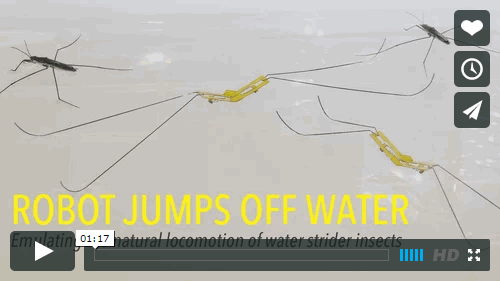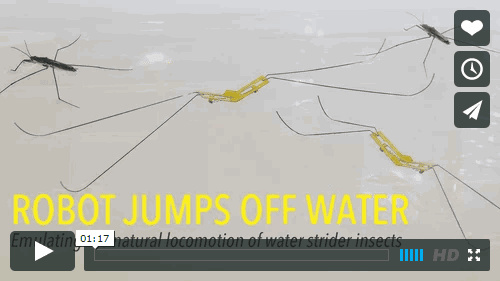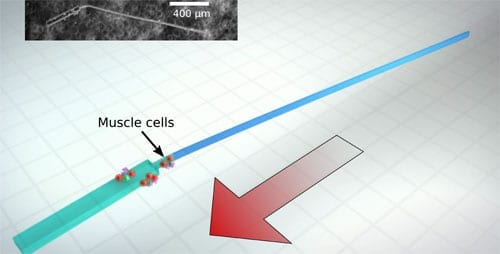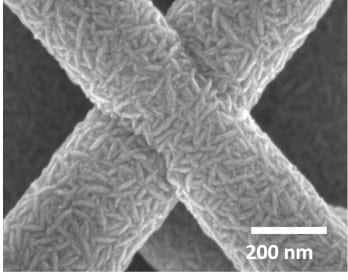
An international team of Seoul National University and Harvard researchers looked to water strider insects to develop robots that jump off water’s surface
The concept of walking on water might sound supernatural, but in fact it is a quite natural phenomenon. Many small living creatures leverage water’s surface tension to maneuver themselves around. One of the most complex maneuvers, jumping on water, is achieved by a species of semi-aquatic insects called water striders that not only skim along water’s surface but also generate enough upward thrust with their legs to launch themselves airborne from it.
Now, emulating this natural form of water-based locomotion, an international team of scientists from Seoul National University, Korea (SNU), Harvard’s Wyss Institute for Biologically Inspired Engineering, and the Harvard John A. Paulson School of Engineering and Applied Sciences, has unveiled a novel robotic insect that can jump off of water’s surface. In doing so, they have revealed new insights into the natural mechanics that allow water striders to jump from rigid ground or fluid water with the same amount of power and height. The work is reported in the July 31 issue of Science.
“Water’s surface needs to be pressed at the right speed for an adequate amount of time, up to a certain depth, in order to achieve jumping,” said the study’s co–senior author Kyu Jin Cho, Associate Professor in the Department of Mechanical and Aerospace Engineering and Director of the Biorobotics Laboratory at Seoul National University. “The water strider is capable of doing all these things flawlessly.”
The water strider, whose legs have slightly curved tips, employs a rotational leg movement to aid it its takeoff from the water’s surface, discovered co–senior author Ho–Young Kim who is Professor in SNU’s Department of Mechanical and Aerospace Engineering and Director of SNU’s Micro Fluid Mechanics Lab. Kim, a former Wyss Institute Visiting Scholar, worked with the study’s co–first author Eunjin Yang, a graduate researcher at SNU’s Micro Fluid Mechanics lab, to collect water striders and take extensive videos of their movements to analyze the mechanics that enable the insects to skim on and jump off water’s surface.
It took the team several trial and error attempts to fully understand the mechanics of the water strider, using robotic prototypes to test and shape their hypotheses.
“If you apply as much force as quickly as possible on water, the limbs will break through the surface and you won’t get anywhere,” said Robert Wood, Ph.D., who is a co–author on the study, a Wyss Institute Core Faculty member, the Charles River Professor of Engineering and Applied Sciences at the Harvard Paulson School, and founder of the Harvard Microrobotics Lab.
But by studying water striders in comparison to iterative prototypes of their robotic insect, the SNU and Harvard team discovered that the best way to jump off of water is to maintain leg contact on the water for as long as possible during the jump motion.
“Using its legs to push down on water, the natural water strider exerts the maximum amount of force just below the threshold that would break the water’s surface,” said the study’s co-first author Je-Sung Koh, Ph.D., who was pursuing his doctoral degree at SNU during the majority of this research and is now a Postdoctoral Fellow at the Wyss Institute and the Harvard Paulson School.
Mimicking these mechanics, the robotic insect built by the team can exert up to 16 times its own body weight on the water’s surface without breaking through, and can do so without complicated controls. Many natural organisms such as the water strider can perform extreme styles of locomotion – such as flying, floating, swimming, or jumping on water – with great ease despite a lack of complex cognitive skills.
Read more: Robotic insect mimics Nature’s extreme moves
The Latest on: Biorobotics
[google_news title=”” keyword=”Biorobotics” num_posts=”10″ blurb_length=”0″ show_thumb=”left”]
via Google News
The Latest on: Biorobotics
- Researchers Unveil Automated Embryo Injection Technology with Broad Applicationson April 26, 2024 at 9:48 am
The University of Minnesota Twin Cities academics have designed an artificial robot that, through machine learning, automates an intricate microinjection procedure of two different organisms that ...
- Analysts Are Bullish on These Healthcare Stocks: Accolade (ACCD), PROCEPT BioRobotics (PRCT)on April 26, 2024 at 5:05 am
There’s a lot to be optimistic about in the Healthcare sector as 3 analysts just weighed in on Accolade (ACCD – Research Report), PROCEPT ...
- Automated machine learning robot unlocks new potential for genetics researchon April 25, 2024 at 5:00 pm
co-lead author on the paper and University of Minnesota mechanical engineering graduate research assistant in the Biosensing and Biorobotics Lab.
- PRCT PROCEPT BioRobotics Corporationon April 22, 2024 at 10:29 pm
PROCEPT BioRobotics Corporation, a surgical robotics company, focuses on developing transformative solutions in urology in the United States and internationally. The company develops, manufactures ...
- PROCEPT BioRobotics Corporation (PRCT)on April 22, 2024 at 9:00 am
SAN JOSE, Calif., April 04, 2024 (GLOBE NEWSWIRE) -- PROCEPT BioRobotics® Corporation (Nasdaq: PRCT), a surgical robotics company focused on advancing patient care by developing transformative ...
- PROCEPT BioRobotics Corp PRCTon April 18, 2024 at 5:00 pm
We sell different types of products and services to both investment professionals and individual investors. These products and services are usually sold through license agreements or subscriptions ...
- MSc Bioroboticson September 20, 2023 at 4:47 am
The programme centres around a common core in fundamental robotics and life sciences, followed by dedicated taught- and project-based biorobotics units that will walk you through latest research and ...
- PROCEPT BioRobotics Corporation (PRCT)on October 19, 2022 at 10:10 pm
Overall score is calculated based on proprietary scores based on sector averages in key company indicators: fair value, dividends, innovation, hiring, and insider sentiment. Note: if you don't see ...
- PROCEPT BioRobotics Corp.on June 3, 2022 at 8:11 am
PROCEPT BioRobotics Corp. is a commercial-stage surgical robotics company, which engages in the development of transformative solutions in urology. It manufactures and sells the AquaBeam Robotic ...
- PROCEPT BioRobotics Stock (NASDAQ:PRCT), Guidance and Forecaston April 7, 2022 at 9:43 pm
There have been no specific sales or earnings guidance reported for PROCEPT BioRobotics in recent months. Browse guidance and forecast on all stocks.
via Bing News











